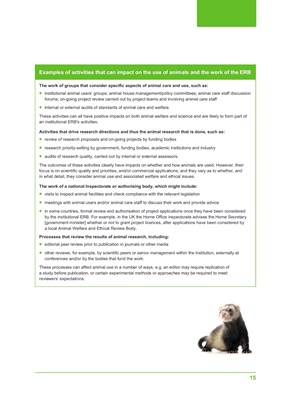
15
Examples of activities that can impact on the use of animals and the work of the ERB
The work of groups that consider specific aspects of animal care and use, such as:
institutional animal users" groups; animal house management/policy committees; animal care staff discussion
forums; on-going project review carried out by project teams and involving animal care staff
internal or external audits of standards of animal care and welfare.
These activities can all have positive impacts on both animal welfare and science and are likely to form part of
an institutional ERB's activities.
Activities that drive research directions and thus the animal research that is done, such as:
review of research proposals and on-going projects by funding bodies
research priority-setting by government, funding bodies, academic institutions and industry
audits of research quality, carried out by internal or external assessors.
The outcomes of these activities clearly have impacts on whether and how animals are used. However, their
focus is on scientific quality and priorities, and/or commercial applications; and they vary as to whether, and
in what detail, they consider animal use and associated welfare and ethical issues.
The work of a national Inspectorate or authorising body, which might include:
visits to inspect animal facilities and check compliance with the relevant legislation
meetings with animal users and/or animal care staff to discuss their work and provide advice
in some countries, formal review and authorisation of project applications once they have been considered
by the institutional ERB. For example, in the UK the Home Office inspectorate advises the Home Secretary
[government minister] whether or not to grant project licences, after applications have been considered by
a local Animal Welfare and Ethical Review Body.
Processes that review the results of animal research, including:
editorial peer review prior to publication in journals or other media
other reviews, for example, by scientific peers or senior management within the institution, externally at
conferences and/or by the bodies that fund the work.
These processes can affect animal use in a number of ways, e.g. an editor may require replication of
a study before publication, or certain experimental methods or approaches may be required to meet
reviewers" expectations.